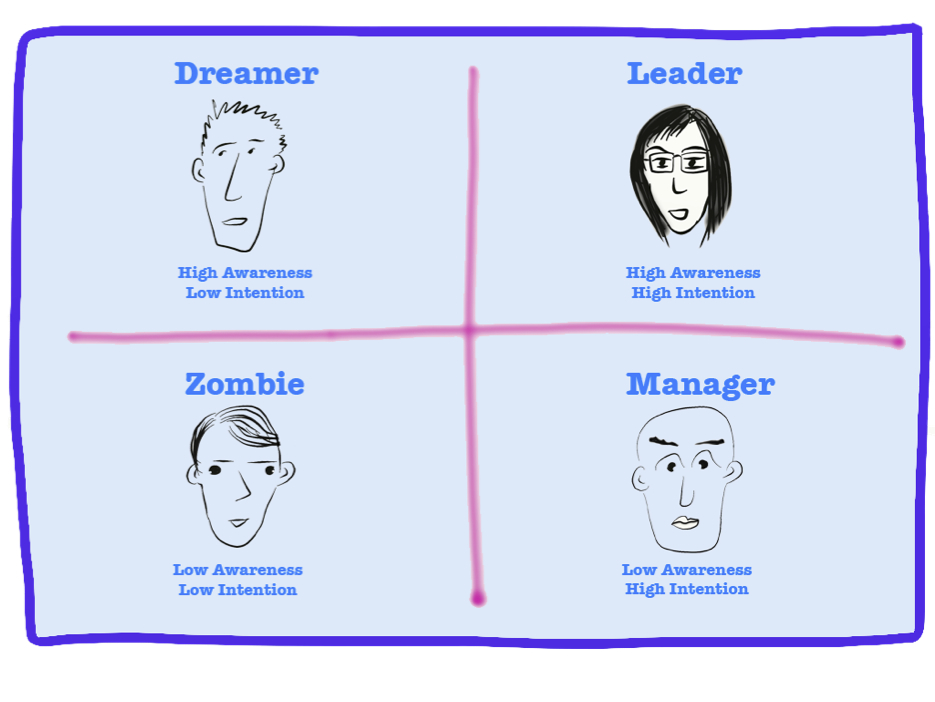I’ve been preparing a new keynote speech on Imagination and it’s been a real challenge to get my thoughts together on such a big and creatively important concept. My focus is usually on Creativity. To be honest I’m enthralled with the concept of imagination, and yet have avoided talking about it directly because it’s so individual and amorphous. That’s why I’m so excited about one aspect of my new talk I wanted to share it with my readers right away, so here it is, my “Johari Window” of Imagination (note to self: need better label). It’s helpful in getting a handle on who imagines and how, and might be helpful to individuals and groups who seek to improve imaginative capacity.
One way to look at Imagination is along two dimensions: Awareness and Intention.
My assumptions: Everyone has imaginative capacity, and, everyone can invoke it if and when they wish to. I assume that nearly everyone has some imaginative thoughts, and I assume that everyone, at some point in time, tries to make use of their imagination. However, many folks have a low awareness of the steam of imaginative thoughts flowing through their minds. Many folks also rarely ask their own minds for imaginative thoughts (be they visuals, words, or sounds).
I’m not talking about imaginative effectiveness. That’s a whole other blog post. It’s not so easy to improve one’s awareness of imaginative thoughts, but it can be done. It’s also not so easy at all to deliberately use imagination to solve problems, but again, there are ways to get better. So, more on effectiveness later. My two dimensional view has to do with segmentation of who’s aware and who’s not, and who’s using, and who’s not using, their imagination.
I think this is where it all starts.
It breaks down into four groups which I’m calling: Zombies, Dreamers, Managers, and Leaders.
Zombies, God bless them, are people who are unaware of their imaginative thoughts and never or rarely call their mind for any. These would not be good employees, for they are walking around in a stupor. They might be in survival mode and too busy to relax, listen, or proactively imagine. I would think they’d be poor problem solvers and might be, frankly, lazy. Wake them up and you might have something. Awareness can be developed by meditation, yoga, walking and other “centering” sorts of behaviours. Start there!
Dreamers are tuned into their imaginations. They like to be there in their head and they notice their dreams, visions, and images. They don’t have to invoke their imaginations much because they are happy riding the unfocused waves of imaginative thoughts they already have. However, because they don’t focus their imagination on any particular problem or challenge, they miss opportunities for real world creativity. Dreamers improve by taking real world action, and, by calling for imaginative ideas focused on challenges in front of them.
Managers try to come up with imaginative ideas, they desire to be problem solvers, but because they are not connected to their core thought streams, tend to lack big picture visions. They are focused on action and sometimes this focus keeps them from accessing deeper or more high level ideas buried in the subconscious. They would do well to develop more awareness, and, ask their minds for bigger, broader images that move beyond their challenges and to the challenges of others.
Leaders, and they don’t always lead people directly, are both aware of their imagination, and, make deliberate use of it. Because they are centred and aware, and because they practice the skill of imagination, they are probably the most creatively effective Imagineers of the four segments.
Would love to hear thoughts about this. Kindest vibes flowing out to all ya’all.




2 responses to “Zombies, Dreamers, Managers and Leaders”
[…] http://greggfraley.com/blog/2013/03/18/zombies-dreamers-managers-and-leaders/ […]
[…] http://greggfraley.com/blog/2013/03/18/zombies-dreamers-managers-and-leaders/ […]